
Perhaps my reasoning for going up through central Virginia ---and heading west on 64 over to I-81 DID have a bit to do with my desire to be in Blue Ridge Mountain Country as much as it did to spend some time wandering around Danville on a search for Dan River plaid quilts –
One of the classes I taught up in Carlisle, PA this week was “Blue Ridge Beauty” after all, and this quilt WAS inspired by my first road trip up through the Blue Ridge somewhere around 2004? 2005?
I can’t remember when I started this quilt with a simple box of 2” squares, using the blues and neutrals as leaders & enders and letting the 4 patches stack up by my machine, pinning them into groups of 10 as the pile grew ----at that point I didn’t even have a block in mind, but after that first drive through Virginia, I knew those 4 patches would have a purpose, and I wanted that purpose to forever capture what I had found and felt that first time I fell in love with the Blue Ridge.
SO --- my “commemorative” trip was the perfect lead in to teaching a wonderful group of ladies just what they could do with this one simple block too! ((Still could have done without the speeding ticket though! OUCH!))
Blue Ridge Beauty is such a simple quilt, really, except it isn’t! So many factors come into play, even with an easy block, and it is my hope with EVERY workshop that I can leave especially the beginners and even the novices with something that they can apply to their quilting skills that make them that much happier with their results.
**Note** This post was going to be a simple slide show, but it took on a direction of its own, and since time is limited for me this morning, I’ll post the slide show a bit later in an effort to not overload this post, and get my day going --- so come back later for the slide show!
The one thing that was a light bulb moment for many this trip? CUTTING! Precise patchwork is much more than the accuracy of your 1/4” seam allowance!
Cutting. I’m serious. You might think that we all know how to cut, but I tell ya…with all the different cutting tools out there, I saw such variations – and it really is the FIRST crucial step in getting good results.
#1 IMPORTANT THING!! If you have invested in taking a class with ANYONE –be it at a shop, or just a little guild workshop, or a class at a quilt show, or even going to retreat--- wherever it be ---have a NEW BLADE in your cutter. AND have a spare blade just in case. And know how to put it in the cutter. If you are right handed and have a certain olfa cutter, the kind with the squeeze handle..((Shown above)) that blade should be up against the ruler side…not behind the plastic thing away from the ruler – those cutters were designed to be lefty OR righty, but not universal --- you have to put the blade on the correct side of the cutter depending if you are right handed or left handed….this one is set up for RIGHT HANDED cutting. If you are a lefty, the blade will go on the other side of the plastic center thing, so that your blade will be right up against the ruler as you cut.
RULERS! If you are doing short cutting, have a ruler that works with what you are cutting and fits the space you are given to cut in. If you have small amount of table space in class…don’t bring a 6” X 24” ruler to sub-cut cut little 4-patch strip sets.
My favorite ruler is a Creative Grids 6.5” X 12.5” ruler and I find it sufficient for most cutting, even when cutting full width of fabric strips, I just fold the fabric and cut through 4 layers. A 6.5” square is going to work fine for cutting those twosies from the strip sets, or for squaring up half square triangles….if the block size is 6.5”, you don’t need the 12.5” X 12.5” huge square up ruler. Trust me. :c)
You are going to want rulers with the easiest to read numbers and lines….and those lines need to be thinner rather than fatter ----I saw rulers with such FAT lines that they are hard to get an accurate cut. There was such a variation in cutting between those who used different rulers when we put those strips side by side! So choose your rulers wisely. The worst ruler I’ve come across had such thick lines….they were supposed to be raised ridges on the back side of the ruler to help hold the fabric steady, but the ridged lines were SO THICK that it made cutting inconsistent. And it was 24” long! I’d save this ruler for doing things like squaring up the quilt edges before putting binding on ---it would be great for that, but for precision cutting, not quite.
The omnigrid rulers with the green bubbles --- HARD HARD HARD to see where the correct line-up is when cutting because the measurement lines are lost inside those green bubbles, at least in my opinion. If you can’t see the edge of your fabric, how can you know where to place that line?
Those June Taylor shape-cut rulers work for some, but if you aren’t careful…the slats can wiggle and slide as you cut, giving you some strips that are thinner because the slats wiggled, and that means the strip next to the skinnier one is going to be too wide…so be careful with those. I prefer not to use them, I want more control over my strips.
The cutting process:
There is one thing I see people doing time and time and time again ---when you cut, you slide the marking line on the ruler right up against the outside edge of the fabric, but the whole line is OFF the fabric. You can short yourself a few threads when doing this, and it might not seem like much, but over the number of seams within a block ----you can end up an easy 1/4” too small on your block, no matter how “perfect” your 1/4” seam is.
In other words, if your strips are too narrow to begin with, it’s not going to be what you want it to be. Add into the equation that we have all those places where we have pressed the seams one direction or another, and we have the thickness of the seam to add into the mix. To compensate for that…this is what I do:
I hope you can see in this picture how I cut this 2” strip. I’ve got the 2” line, the WHOLE LINE ---- ON THE FABRIC..with the left side edge of the line at the outside edge of the fabric..but the whole line is ON the fabric. This helps me make sure that I have not shorted myself on the strip width..and it may give me a couple extra threads that help me with the thickness of the seams when pressing.
And to show you what happens if you cut with line on the ruler NEXT to the fabric, instead of including it ON the fabric, I took this picture:
Can you see the difference? The line is right next to the fabric…but look at the excess that is at the right edge of the ruler. If I’d have trimmed here, I would have shorted myself THAT MUCH. And over time within my blocks…that shortage adds up to quite a bit.
And as I’m thinking about how to word this and explain why I do what I do ---I realize that basically instead of “scanting down” my 1/4” seam allowance, I’m “scanting up” my strip widths to compensate for the thicknesses of pressed-to-the-side seams and bulky intersections, and I get the best results with my patchwork if I follow this simple rule I made for myself.
LINE ON! Not LINE OFF!
So that’s your basic cutting lesson today. Find the tools that work for you, Easy to read numbers, thin lines for accuracy, and in a size that is right for the job, but isn’t overkill for the space you have to work.
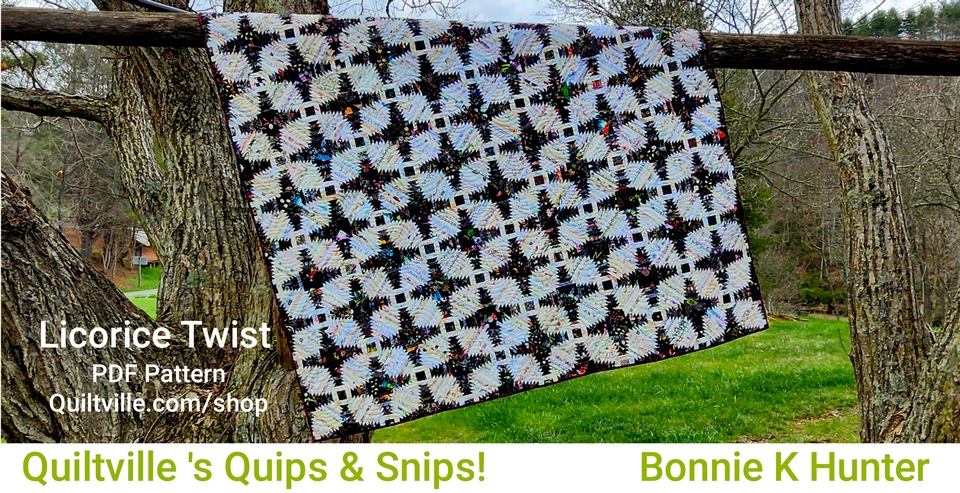
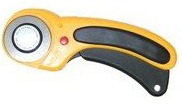
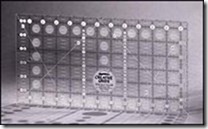
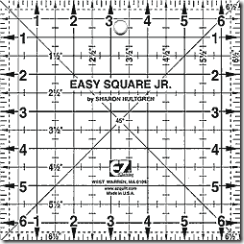
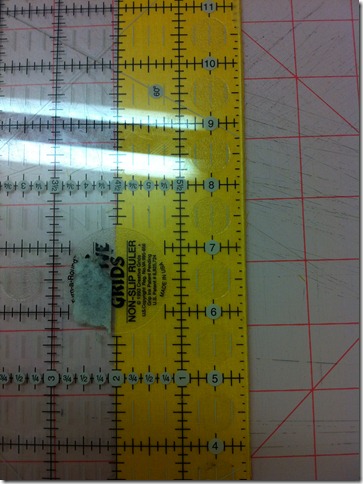
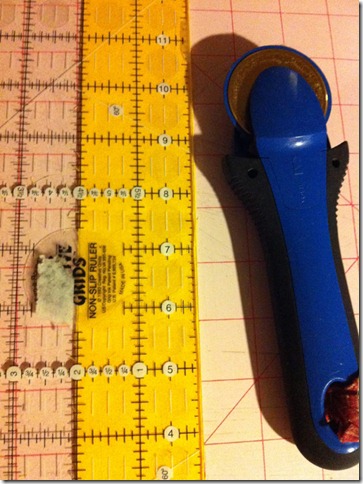
I very much agree. I can shave a thread or two off by squaring up, but can't add fabric, that's my reasoning. Have fun in Annapolis. Will be wishing I could attend from St. Mary's county.
ReplyDeleteWell said..people give me their scrap or left over strips and almost always I have to cut them down to the next size because they are too small....My mother is from Danville and I never knew the history of the mills...the things we let get away and then it is too late.... Joaniegirl lakeland FL
ReplyDeleteThank you so much for the info in cutting. Since I did the orca bay and read your tips on rulers and cutting my work has improved and trimming is to a min. Blocks fit better also. Do you have to sew scant seams if you use acuquilt ? They don't work too well for me
ReplyDeleteDonna
donnagauch@hotmail.com
That was well said, Bonnie! We all need reminders. It DOES make a big difference. Thanks
ReplyDeleteThanks Bonnie! I think this will help my cutting skills. My blocks don't always come out the size your patterns state. At first I thought I wasn't getting a consistent 1/4 inch seam, but I've gotten pretty good at that. Because my blocks come out pretty consistently sized, I realized it had to be in my cutting. Knowing how the designer measures and cuts helps me realize what I am doing differently. Thanks for taking the time to put this all in writing - and pictures!
ReplyDeleteSafe travels!
Great post, Bonnie! Thanks for the lesson. I agree with Kelly - my 1/4 seam is very consistent, but I somehow end up with blocks that are just a little too small. When I am making my own patterns, it isn't a problem, but when I am working with someone else's pattern, it gets very frustrating. I am definitely going to try your cutting method from now on.
ReplyDeleteBonnie... I've "PinInterested" your blue heart... It's absolutely GORGEOUS!!!
ReplyDeleteBTW, where would I find the pattern to this? Is it out, yet?
And yes, thanks for the lesson !!!!
Rosa Robichaud
Saint John, New Brunswick
*the one that got a HUGE hug from you via Cyn Forrest... a couple weeks ago! VBG*
I've also been told that you should stick with one "brand" of rulers within a project so that your gauge stays the same throughout. Seems like good advice, given your experience with the thick-lined ruler.
ReplyDeleteGreat little tutorial, Bonnie. Thank you for your constant assistance to even those who have been "at it" for a long time.
ReplyDeleteYour photos demonstrate the difference that good lighting (from the right direction) can make, too!
ReplyDeleteThanks, Bonnie, this is very helpful.
ReplyDeleteTerry
wow ... there's so much good info in this one post ... i dread looking at my mishmash of rulers!
ReplyDeleteTHANK YOU !!!
Thank you for this wonderful lesson in cutting. You always have the best tips! I use an acrylic self adhearing strip that I attach to the back of my ruler right up tight to the line of the width I want to cut. It does exactly what you said.....gives me the correct width of strip. I just slide the ruler up to the fabric edge, double check that the fabric is up against the guide strip and hasn't shifted. This keeps my strips the same size with each new cut. I pretty much only own one brand of ruler and it's the one that I can read the easiest. I had just one experience with one of those rulers with the raised ridge type inch marks.....YUCK! Thank goodness I had borrowed it and not bought it!
ReplyDeleteThanks for the cutting tips. I've debated many times on where on each line I should make my cuts. I've settled on the middle, but now I'm going to switch to the left side. Thanks again. I always learn so much from you!
ReplyDeleteAwesome post thsnkkks!
ReplyDeleteThanks so much Bonnie!That's a great reminder because there are times I just want to get the cutting over with and I relly need to pay more attention. It'll certainly cause less grief in the end.Your photos are very helpful. Suddenly I have this overwhelming need to watch The Karate Kid. :)
ReplyDeleteFabric cutting is a skill and a time consuming one for me. I think the fabric die cutting machines are the best things since the rotary cutter. I rarely have to square up my blocks when using the die cuts.
ReplyDeleteFabric cutting is a skill and a time consuming one for me. I think the fabric die cutting machines are the best things since the rotary cutter. I rarely have to square up my blocks when using the die cuts.
ReplyDeleteThank you Bonnie. Cutting is not my favorite part of making a quilt. VEry helpfull info that I will share with my guild! Now I need help in having less seams when joining multiple pieces of fabric together. Orca Bay with the multiple fabric intersections produced bulky areas. What can be done to prevent this? By the way I love your blogs and your books. Too many quilts on my 'need' to make list from them!!
ReplyDeleteIt is surprising how casually some people take the cutting. If you aren't precise at that step, it doesn't matter how precise you are anywhere else! Well done!
ReplyDeleteThank you Bonnie! It is these little details that many of us can easily overlook, and be unhappy with cutting results.
ReplyDeleteYou are so correct telling us to get rulers we can read!!! No Joke! Next? When will they be making non-glare rulers lolol. I need light to see better, but many times am fighting the light glare. Let us know if you have found a way of curb this maddening glare.
Thanks again,
JulieinTN
Bonnie you are so correct. I work at a quilt shop and that is the main thing I try to stress to beginners.
ReplyDeleteLove your Blog
Diane
Can't believe the timing! I am just starting to practice on making churn blocks so I can incorporate them into a quilt I am planning. I was fussing last night about the cutting, hard to read rulers, where to put the line on the fabric, as well as Everything else you covered in this post...Thank you! I would like to print it out and keep it in my special notebook, just for me...may I do that?....
ReplyDeleteLove this information! I love my Creative Grid rulers because they are so easy to read, even though I have some of those green, and the older yellow, rulers. Is it okay to print it out and distribute it to my classes?
ReplyDeleteKathy M
kathy.marlowe@gmail.com
I'd like to see some LEFT-HANDED rulers. I am constantly flipping mine and am tired of reading the numbers upside down and backwards. Those designed for both RH and LH are too cluttered to read. I would like a LEFTY ONLY ruler. I would even design it if I could get someone to actually make one. ;))
ReplyDeleteI use my cutting mat to measure...I know, I know I am not supposed to, but I mostly taught myself and it has worked for me..by the time someone told me I was doing it wrong I was used to doing it that way. My stuff comes out fine that way so I have no motivation to change, wish I had seen this post back when!
ReplyDeleteThank you for all the info you impart to us. I LOVE all your tips, tricks & quilts. What I got from the above is: SIZE MATTERS!! Thanks again, Janine
ReplyDeleteThat's the way I do it too. And I LUV the Creative Grids rulers.
ReplyDeletethanks for the advice, always a great tip to refresh my memory! keep them coming! :)
ReplyDeleteHeather
Great post about cutting. I had quilted/cut for years before (last year!) I learned that you want the ruler line ON the fabric, not just over the edge. I know my sizing is much more accurate on my blocks now. I am a big fan of the Creative Grids ruler; the markings show up on light and drak fabrics and don't impede my view.
ReplyDeleteThe creative grid ruler is a little confusing to me if your measuring for instance for 3" it will say 3 then above is 3/1/2 so I have to be very careful and check closely hope this makes sence...Thanks for the tutorial...
ReplyDeleteI wish I had know this years ago. Thank you go much for this much needed lesson.
ReplyDeletegidget ramsey rmsybkrgrl@yahoo.com i think i will wait for the slide show, i don't think i'm understanding what is being said, i do better with videos lol, i could use a good class on cutting because i've noticed at times i may come up a bit short or even to much at times, i would love to be better at what i do. ty Bonnie.
ReplyDeleteI came to this conclusion years ago. I'm glad to hear a major quilt teacher say the same thing I have been thinking.
ReplyDeleteThanks for sharing this tip!
ReplyDeleteWhen I use the slatted ruler to cut strips, I lay a 6" ruler over the slats next to the slat I will be cutting in, so when I cut the ruler holds them in place.
ReplyDeleteI also agree with you about the Omni Grid rulers. I have switched to the Creative Grid rulers.
I am so glad to see this issue addressed! When I was a "newbie" quilter, I had no idea exactly where the line should fall. In my lack of knowledge, I have ended up buying rulers that are useless! I hate it when they have ads and writing all over them, blocking my view of my fabric edge. I do have both the rulers you have pictured, and I use the heck out of the 6.5 inch square, to the point I have worn off some of the lines! THANK YOU!!!
ReplyDeleteThank you for clearing the ruler question for me. I am going to go through my rulers and check on those measurement mark.
ReplyDeleteI've always ended up with my blocks ending up a smidge too small. I'm going to try your method and hopefully it will help me!! Thanks! Hugs from Helen in Healdsburg
ReplyDelete